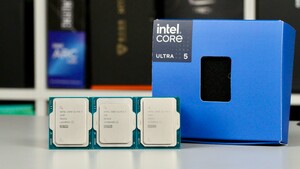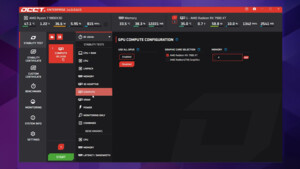Häää??? Scheint wohl so, als hättest Du etwas nicht verstanden. Die Loadline bestimmt, wie stark die Spannung bei Belastung fällt. Mit steigendem LLC sinkt der Widerstand und damit der Drop der Spannung unter Belastung. Damit die CPU nun seine Kalkulation für die Spannungsversorgung exakt vornehmen kann, musst Du ihm mitteilen, mit welchem LLC quasi der Drop kompensiert wird. Das wird über den DC_LL gemacht. Wenn beide Werte identisch sind, dann ist Vcore=CoreVID. Der Kollege hat bislang sein DC_LL für seine LLC High Stufe ermittelt. Anschließend kann er mit dem AC_LL seine "freigegebene" Versorgungsspannung einstellen. Sobald AC_LL<DC_LL ist, wird die CPU undervoltet. Nur klappt das bei ihm, aus welchem Grund auch immer, nicht. Gigabyte typisch eben. Aus dem Grund habe ich ihm gesagt, er soll die Stufe Medium wählen und sein DC_LL für Medium herausfinden, um von vornherein die Spannung nicht so hoch anzusetzen. Du hast mit unwissen Werte für Asus Mainboards eingestellt, die für LLC Stufe 4 bei Asus Boards vorgesehen waren, dein LLC auf Auto gelassen, damit glück gehabt und spielst nun den Experten? So funktionert das nicht. Hier anbei die Beschreibung zu Loadline, AC_LL und DC_LL.
- Understanding LLC, AC_LL & DC_LL:
Let's first understand load lines:
For this, didactically, we will exchange the electric current for a flow of water.
[IMG]https://www.overclock.net/cdn-cgi/image/format=auto,onerror=redirect,width=1920,height=1920,fit=scale-down/https://www.overclock.net/cdn-cgi/image/format=auto,onerror=redirect,width=1920,height=1920,fit=scale-down/https://www.overclock.net/attachments/1636656737349-png.2532000/[/IMG]
Our goal is to adjust the circuit so that the tanks remain at the same levels at all times, regardless of LOAD.
The resistance to the passage of water in the “Load Line” piping is physical and intrinsic to its construction.
(This is the physical wire from the VRM to the CPU).
As the LOAD varies all the time, the CPU tank level tends to get higher or lower than the VRM tank in an uncontrolled way.
So let's take control !
For that we have 2 pumps: the LLC pump and the AC_LL pump.
The first thing to do is to choose an LLC pump that will compensate for losses in the load line pipe.
(This is the VRM impedance characteristic, which determines the voltage drop as current flows).
Ideally, the pump should be neither too strong nor too weak.
We have 8 LLC pumps to choose from.
Pumps #7 and #8 are very strong and are not viable for daily use. So we have six pumps left.
It seems to me a good idea to choose an intermediate pump, #3 for example, but we can choose any one of these 6 pumps, as long as we make adjustments in the control circuit.
All this control will be done by the CPU, so we must inform which pump we choose through the DC_LL parameter. This way, the value of DC_LL (milliohms) must match the value of LLC (milliohms) chosen so that the CPU does all the calculations correctly.
The next pump to choose is AC_LL.
(This is the load variation compensation component).
This parameter makes the CPU, upon perceiving an increase in the water flow to the LOAD, to increase the VID value sent to the VRM, in order to anticipate the losses that this flow increase could cause. Therefore, the VRM uses the LLC and AC_LL pumps to fulfill the CPU VID request.
So if we have a stronger LLC pump, we can use a weaker AC_LL pump and vice versa.
Some combinations are not recommended, for example: two weak pumps or two strong pumps.
All this game can be done according to the desired goals.
Comparison with fixed voltage:
[IMG]https://www.overclock.net/cdn-cgi/image/format=auto,onerror=redirect,width=1920,height=1920,fit=scale-down/https://www.overclock.net/cdn-cgi/image/format=auto,onerror=redirect,width=1920,height=1920,fit=scale-down/https://www.overclock.net/attachments/1636668041531-png.2532029/[/IMG]
When we decide to use "voltage override" we turn off all this controls described before.
The selected LLC pump and the VID manually set will feed the level of the CPU tank without a control.
In this case, when the flow to the load rises, the level of the CPU tank goes down... And when the flow to the load decreases, the level of the CPU tank goes up...
So, bye bye level control.... 😂
You will need to run all the time with more voltage than you need, for that specific frequency, just waiting for when the heavy load comes.
If you think you can do a better job than the CPU algorithm, use fixed voltage, don't worry about AC_LL and DC_LL. Set an LLC #5, 6 or 7...
But I think it's a better idea to use this extra voltage to reach high frequencies...






